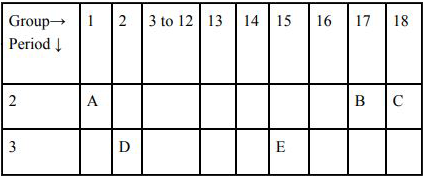Consider the following elements :
20A,8B,18C,16D,4E,2F
Answer the following giving reasons :
What type of bond will be formed when the element A reacts with B? Explain.
To determine the type of bond formed when element A reacts with element B, we need to analyze the electronic configurations and the behavior of these elements based on their atomic numbers.
1. Identify the Elements and Their Atomic Numbers:
- Element A has an atomic number of 20.
- Element B has an atomic number of 8.
2. Determine the Electronic Configurations:
- For element A (atomic number 20):
- The electronic configuration is 2,8,8,2. This means it has 2 electrons in its outermost shell (valence shell).
- For element B (atomic number 8):
- The electronic configuration is 2,6. This means it has 6 electrons in its outermost shell.
3. Analyze the Valence Electrons:
- Element A has 2 valence electrons and can easily lose these electrons to achieve a stable electronic configuration (octet).
- Element B has 6 valence electrons and needs 2 more electrons to complete its octet.
4. Determine the Type of Bond:
- Element A will lose 2 electrons, becoming a positively charged ion (A2+).
- Element B will gain 2 electrons, becoming a negatively charged ion (B2−).
- The electrostatic attraction between the positively charged ion (A) and the negatively charged ion (B) leads to the formation of an ionic bond.
5. Conclusion:
- The bond formed when element A reacts with element B is an ionic bond. The resulting compound will have the formula AB.
- Element A has an atomic number of 20.
- Element B has an atomic number of 8.
- For element A (atomic number 20):
- The electronic configuration is 2,8,8,2. This means it has 2 electrons in its outermost shell (valence shell).
- For element B (atomic number 8):
- The electronic configuration is 2,6. This means it has 6 electrons in its outermost shell.
- Element A has 2 valence electrons and can easily lose these electrons to achieve a stable electronic configuration (octet).
- Element B has 6 valence electrons and needs 2 more electrons to complete its octet.
- Element A will lose 2 electrons, becoming a positively charged ion (A2+).
- Element B will gain 2 electrons, becoming a negatively charged ion (B2−).
- The electrostatic attraction between the positively charged ion (A) and the negatively charged ion (B) leads to the formation of an ionic bond.
- The bond formed when element A reacts with element B is an ionic bond. The resulting compound will have the formula AB.
Topper's Solved these Questions
- FOOTSTEPS TOWARDS CBSE BOARDBOOK - MTG IIT JEE FOUNDATIONCHAPTER - FOOTSTEPS TOWARDS CBSE BOARDEXERCISE - SECTION - B
34 Videos
- FOOTSTEPS TOWARDS (JEE MAIN) BOOK - MTG IIT JEE FOUNDATIONCHAPTER - FOOTSTEPS TOWARDS (JEE MAIN) EXERCISE - Integer/Numerical Value Type
5 Videos
- METALS AND NON METALS BOOK - MTG IIT JEE FOUNDATIONCHAPTER - METALS AND NON METALS EXERCISE - Olympiad/HOTS Corner
20 Videos
Similar Questions
Consider the following elements :
20A,8B,18C,16D,4E,2F
Answer the following giving reasons :
Which of the given elements is (are) called noble gas?
View SolutionConsider the following elements :
20A,8B,18C,16D,4E,2F
Answer the following giving reasons :
Which of the above elements you would expect to be
very stable
View SolutionConsider the following elements :
20A,8B,18C,16D,4E,2F
Answer the following giving reasons :
Which of the above elements you would expect to be
in group 16 of the periodic table?
View SolutionConsider the following elements :
20A,8B,18C,16D,4E,2F
Answer the following giving reasons :
Which of the above elements you would expect to be
in group 2 of the periodic table.
View SolutionConsider the following elements :
20A,8B,18C,16D,4E,2F
Answer the following giving reasons :
Which of the above elements you would expect to be
(i) very stable.
(ii) in Group 2 of the Periodic Table.
(iii) in Group 16 of the Periodic Table.
(iv) What type of bond will be formed when the element A reacts with B? Explain.
View SolutionFrom the following elements:
4Be,9F,19K,20Ca
(i) Select the element having one electron in the outermost shell.
(ii) Two elements of the same group. Write the formula and mention the nature the compound formed by the union of 19K and element X (2,8, 7).
View SolutionConsider the following elements,
20Ca,8O,18Ar,16S,4Be,2He
Which of the above elements would you expect to be:
(i) very stable? (ii) in group 2 of the periodic table?
(iii) in group 16 of the periodic table?
View SolutionThe following table shows the position of five elements A, B, C, D and E in the modern periodic table.

Answer the following giving reasons:
(i) Which element is a metal with valency two?
(ii) Which element is least reactive?
(iii) Out of D and E which element has a smaller atomic radius?
View SolutionFour elements A,B,CandD have the following electron arrangement in their atoms :
A- 2, 8, 6
B - 2, 8, 8
C - 2, 8, 8, 1
D - 2, 7
(a). What type of bond is formed when element C combines with element D ?
(b). Which element is an inert gas ?
(c). What will be the formula of the compound between A and C ?
View SolutionAn element P(atomic number 20) reacts with an element Q (atomic number 17) to form a compound. Answer the following questions giving reasons :
(a) Write the positions of P and Q in the Modern Periodic Table.
(b) Write the molecular formula of the compound when P reacts with Q.
View Solution
